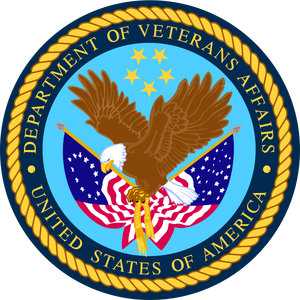The United States Department of Veterans Affairs (VA) is a government-run military veteran benefit system with Cabinet-level status. It is the United States government’s second largest department, after the United States Department of Defense. With a total 2009 budget of about $87.6 billion, VA employs nearly 280,000 people at hundreds of Veterans Affairs medical facilities, clinics, and benefits offices and is responsible for administering programs of veterans’ benefits for veterans, their families, and survivors.
The benefits provided include disability compensation, pension, education, home loans, life insurance, vocational rehabilitation, survivors’ benefits, medical benefits and burial benefits. It is administered by the United States Secretary of Veterans Affairs.
History[]
The United States has the most comprehensive system of assistance for veterans of any nation in the world. This benefits system traces its roots back to 1636, when the Pilgrims of Plymouth Colony were at war with the Pequot Indians. The Pilgrims passed a law which stated that disabled soldiers would be supported by the colony.
The Continental Congress of 1776 encouraged enlistments during the Revolutionary War by providing pensions for soldiers who were disabled. Direct medical and hospital care given to veterans in the early days of the Republic was provided by the individual States and communities. In 1811, the first domiciliary and medical facility for veterans was authorized by the Federal Government. In the 19th century, the Nation's veterans assistance program was expanded to include benefits and pensions not only for veterans, but also their widows and dependents.
After the Civil War, many State veterans homes were established. Since domiciliary care was available at all State veterans homes, incidental medical and hospital treatment was provided for all injuries and diseases, whether or not of service origin. Indigent and disabled veterans of the Civil War, Indian Wars, Spanish-American War, and Mexican Border period as well as discharged regular members of the Armed Forces were cared for at these homes.
Congress established a new system of veterans benefits when the United States entered World War I in 1917. Included were programs for disability compensation, insurance for servicepersons and veterans, and vocational rehabilitation for the disabled. By the 1920s, the various benefits were administered by three different Federal agencies: the Veterans Bureau, the Bureau of Pensions of the Interior Department, and the National Home for Disabled Volunteer Soldiers.
The establishment of the Veterans Administration came in 1930 when Congress authorized the President to "consolidate and coordinate Government activities affecting war veterans." The three component agencies became bureaus within the Veterans Administration. Brigadier General Frank T. Hines, who directed the Veterans Bureau for seven years, was named as the first Administrator of Veterans Affairs, a job he held until 1945.
The VA health care system has grown from 54 hospitals in 1930, to include 171 medical centers; more than 350 outpatient, community, and outreach clinics; 126 nursing home care units; and 35 domiciliaries. VA health care facilities provide a broad spectrum of medical, surgical, and rehabilitative care. The responsibilities and benefits programs of the Veterans Administration grew enormously during the following six decades. World War II resulted in not only a vast increase in the veteran population, but also in large number of new benefits enacted by the Congress for veterans of the war. The World War II GI Bill, signed into law on June 22, 1944, is said to have had more impact on the American way of life than any law since the Homestead Act more than a century ago. Further educational assistance acts were passed for the benefit of veterans of the Korean Conflict, the Vietnam Era, Persian Gulf War, and the All-Volunteer Force.
In 1973, the Veterans Administration assumed another major responsibility when the National Cemetery System (except for Arlington National Cemetery) was transferred to the Veterans Administration from the Department of the Army. The Agency was charged with the operation of the National Cemetery System, including the marking of graves of all persons in national and State cemeteries (and the graves of veterans in private cemeteries, upon request) as well and administering the State Cemetery Grants Program.
The Department of Veterans Affairs (VA) was established as a Cabinet-level position on March 15, 1989. President Bush hailed the creation of the new Department saying, "There is only one place for the veterans of America, in the Cabinet Room, at the table with the President of the United States of America."
Organizations[]
Organization[]
- VA Organization Chart (pdf)
- VA Organization Briefing Book (pdf)
Administrations[]
- Veterans Health Administration
- Veterans Benefits Administration
- National Cemetery Administration
Staff Offices[]
- Office of Public and Intergovernmental Affairs
- Office of Management
- Office of Information and Technology
- Office of Human Resources and Administration
- Office of Operations, Security and Preparedness
- Office of Policy and Planning
- Office of Congressional and Legislative Affairs
- Office of Acquisition, Logistics, and Construction
Staff Organizations[]
- Board of Veterans' Appeals
- General Counsel
- Office of Regulation Policy and Management
- Inspector General
- Veterans Service Organizations Liaison
- Center for Minority Veterans
- Center for Women Veterans
- Office of Advisory Committee Management
- Office of Survivors Assistance
- Office of Employment Discrimination Complaint Adjudication
- Small and Disadvantaged Business Utilization
- Center for Veterans Enterprise
- Center for Faith-Based and Community Initiatives
